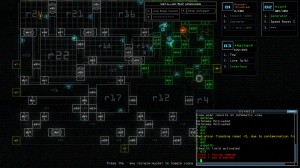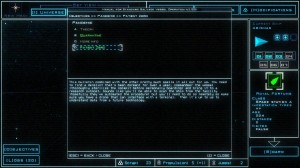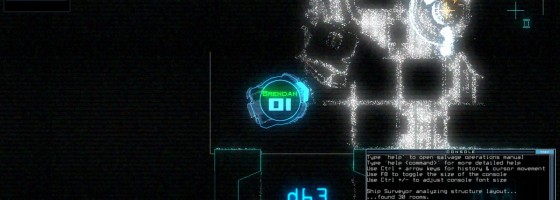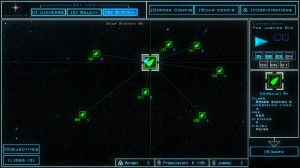Duskers is the next game from studio Misfits Attic and represents a huge departure from their lighthearted puzzle game a Virus Named Tom. This time around, a dark desolate future awaits you with your only allies are drones and a lone command console.
(This spotlight is taken from the Alpha of Duskers, which at this time is version .21. Screenshots and impressions may not represent the current version of the game. You can buy Duskers on Early Access now and the developers are hoping for three to six months of updates and work before officially releasing it.
A Dirty Future:
Duskers’ story takes place sometime in the far future, where you awaken as the sole survivor of a ship with only a few days of fuel left and no clue where you are or what happened to the rest of humanity. Your only option are derelict ships, stations and more with no signs of life for you to explore. Aiding you is a set of basic drones that come equipped with upgrade modules that let them perform specific tasks.
Duskers’ universe is entirely procedurally generated when you start a new game and you are given a random assortment of drones and upgrades. The universe is broken down into systems and then sectors that have places for you to explore. How it works is that in each sector, you have a limited number of proportion jets to move within the sector. When they run out, you need to enter warp via fuel cells in order to replenish them, fuel cells are found on ships and if you run out, you will be stranded.
Each derelict is also procedurally generated and before you enter one, you’ll be given an idea of what it is, how long it has been adrift and if there are any infestations or enemy types on board.
All this is presented using a dirty tech aesthetic; where even though you’re in the future, there are basic readout screens similar to the movie Alien.
The game’s commitment to this aesthetic is great and it really helps to set the mood; not only that, but you can play the entire game using a keyboard thanks to it.
After selecting your target and equipping your drones, it’s time to step foot into the unknown and where Duskers takes the dirty tech aesthetic even further.
Command Prompt:
The gameplay of Duskers is all about commanding your drones to explore and recover useful information and resources; however you’re not going to be seeing the universe for what it is. Instead, the entire game is played through the viewpoint of your command console and all footage is fed to you via the drones’ camera system. You can directly move a drone via the keyboard, but to do multiple orders and take charge, you need to use the command console.
On the bottom right corner of the screen, you have a command prompt that lets you issue orders to the ship and the drones themselves. Opening and closing doors require you to type in the door code into the console and you can command multiple drones to move via “navigate” and the drone numbers. You can view the entire schematic of the ship via the spacebar; this allows you to see all room numbers and their respective door codes. Upgrades which are attached to your drones can be used by typing their name into the command prompt and there is a help guide for more information on what they do.

Ship exploration hinges on your use of the command prompt and keeping an eye on the schematics to figure out what’s going on
The upgrades are very important as they are your sole means of interacting with the world. “Generator” and “Gather” are the two big ones at the start; the former allows you to turn on generators to power up sections of the ship and gather lets you pick up scrap and fuel.
Things start out innocently enough, as you find upgrade modules that you can take back and even more drones to take into a ship, but then things change. You’ll soon find that the universe is filled with hostiles of a variety of types, and they are out to destroy your drones and your only means of survival.
Because your drones have no offensive capabilities inherent to them, you’ll need to improvise ways to destroy or avoid enemies. The most basic way is clever use of opening and closing doors to lure enemies into abandoned sections of the ship. Advanced modules will let you set up traps, lure and just flat out attack enemies, but you’ll never know where you’ll find those modules.
This creates an interesting dynamic and one I like with Duskers and how you are forced to change your strategies based on the enemies you find and what modules you have active. So while the basic gameplay remains the same throughout, you’ll constantly be on edge as you try to find the best ways of surviving while making sure your drones don’t bite the dust.
One thing that’s interesting about Duskers is how you walk that line between being all powerful and helpless thanks to your modules. Ship modules allow you to control things from your own ship and can give you a major advantage, however they are hard to find and you have limited space. Expert players can take over derelict ships that have more room for modules, but you must clear the entire ship first.

Your drones are your eyes, ears and only means of exploring the variety of derelicts you’ll find out in the universe
Finally in terms of mechanics, you can upgrade modules and drones using scrap back at your ship. Modules will eventually break down and you’ll have to either spend the scrap to repair them or lose their functionality until you find another copy.
This further feeds into the desolate future of Duskers as you do your best to scavenge everything and anything that you can find in order to keep going. The developers promise that there will be storylines for you to follow and more events and situations as the game is expanded.
At this point, Duskers is very much along in terms of mechanics and the game design, but I do want to touch on the game’s command prompt because it is going to be a polarizing point along with a few points I want to go over.
Error Log:
Duskers is an example of a game with explicit design, meaning that the developer wants you to interact and use the game in a specific way that may or may not be the most optimal and in this case it’s the command prompt. The command prompt is a sluggish means of interacting and while it does tie into the aesthetic of the game nicely, I’m not sure how well it’s going to hold up over hours of play which Duskers is aiming for. As an example, I found it a lot safer and smoother to order one drone around manually to check for enemies, than using the schematic view and command prompt for group orders.

There are quests for you to go after at your leisure, with more coming as the game continues to be developed
One thing I noticed was that it was very hard to deal with emergencies due to the interaction speed of the command prompt; again this is conscious design choice, but it can be frustrating to lose your entire drone team due to it.
This is a game where you can go from an easy time to flat out losing over the course of one ship if you get unlucky with enemies or events like module breakdowns.
Speaking of modules, if you run out of ways to detect enemies without putting your drones in harm’s way, things will become very nasty for you.
Adrift:
Duskers shows a lot of promise as an up and coming rogue-like, even at this very early stage of Alpha. I’m curious to see if or how the game’s mechanics will be expanded upon and what things will be added to give the game a greater plot. For more on Duskers, you can watch my current play of it now that it’s out on this playlist.



